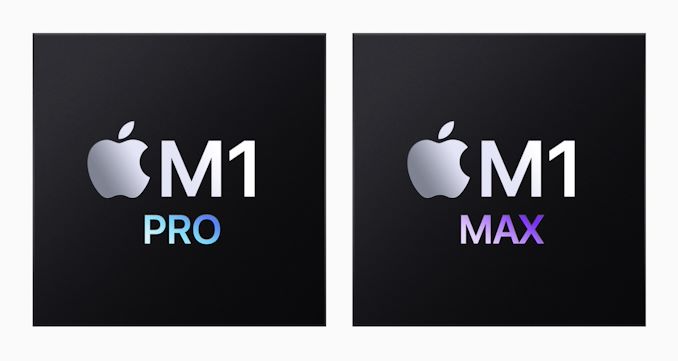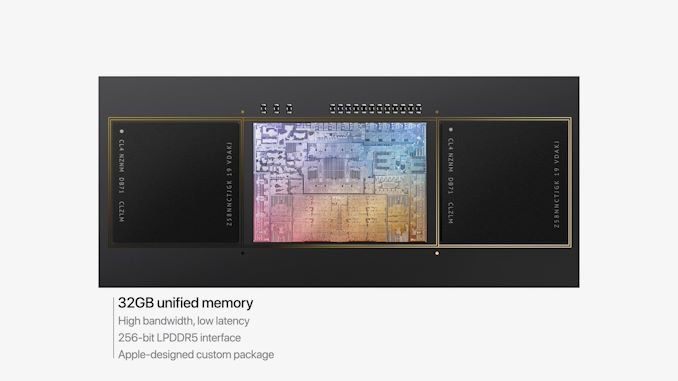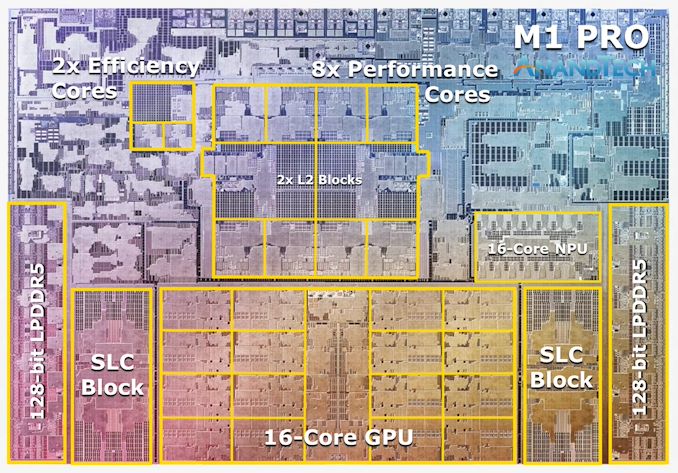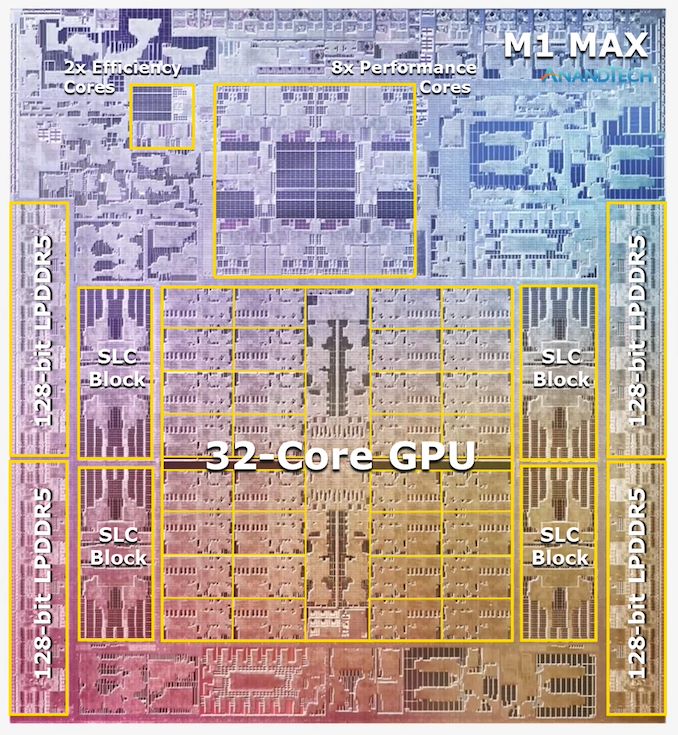Apple's M1 Pro, M1 Max SoCs Investigated: New Performance and Efficiency Heights
by Andrei Frumusanu on October 25, 2021 9:00 AM EST- Posted in
- Laptops
- Apple
- MacBook
- Apple M1 Pro
- Apple M1 Max

Last week, Apple had unveiled their new generation MacBook Pro laptop series, a new range of flagship devices that bring with them significant updates to the company’s professional and power-user oriented user-base. The new devices particularly differentiate themselves in that they’re now powered by two new additional entries in Apple’s own silicon line-up, the M1 Pro and the M1 Max. We’ve covered the initial reveal in last week’s overview article of the two new chips, and today we’re getting the first glimpses of the performance we’re expected to see off the new silicon.
The M1 Pro: 10-core CPU, 16-core GPU, 33.7bn Transistors
Starting off with the M1 Pro, the smaller sibling of the two, the design appears to be a new implementation of the first generation M1 chip, but this time designed from the ground up to scale up larger and to more performance. The M1 Pro in our view is the more interesting of the two designs, as it offers mostly everything that power users will deem generationally important in terms of upgrades.
At the heart of the SoC we find a new 10-core CPU setup, in a 8+2 configuration, with there being 8 performance Firestorm cores and 2 efficiency Icestorm cores. We had indicated in our initial coverage that it appears that Apple’s new M1 Pro and Max chips is using a similar, if not the same generation CPU IP as on the M1, rather than updating things to the newer generation cores that are being used in the A15. We seemingly can confirm this, as we’re seeing no apparent changes in the cores compared to what we’ve discovered on the M1 chips.
The CPU cores clock up to 3228MHz peak, however vary in frequency depending on how many cores are active within a cluster, clocking down to 3132 at 2, and 3036 MHz at 3 and 4 cores active. I say “per cluster”, because the 8 performance cores in the M1 Pro and M1 Max are indeed consisting of two 4-core clusters, both with their own 12MB L2 caches, and each being able to clock their CPUs independently from each other, so it’s actually possible to have four active cores in one cluster at 3036MHz and one active core in the other cluster running at 3.23GHz.
The two E-cores in the system clock at up to 2064MHz, and as opposed to the M1, there’s only two of them this time around, however, Apple still gives them their full 4MB of L2 cache, same as on the M1 and A-derivative chips.
One large feature of both chips is their much-increased memory bandwidth and interfaces – the M1 Pro features 256-bit LPDDR5 memory at 6400MT/s speeds, corresponding to 204GB/s bandwidth. This is significantly higher than the M1 at 68GB/s, and also generally higher than competitor laptop platforms which still rely on 128-bit interfaces.
We’ve been able to identify the “SLC”, or system level cache as we call it, to be falling in at 24MB for the M1 Pro, and 48MB on the M1 Max, a bit smaller than what we initially speculated, but makes sense given the SRAM die area – representing a 50% increase over the per-block SLC on the M1.
The M1 Max: A 32-Core GPU Monstrosity at 57bn Transistors
Above the M1 Pro we have Apple’s second new M1 chip, the M1 Max. The M1 Max is essentially identical to the M1 Pro in terms of architecture and in many of its functional blocks – but what sets the Max apart is that Apple has equipped it with much larger GPU and media encode/decode complexes. Overall, Apple has doubled the number of GPU cores and media blocks, giving the M1 Max virtually twice the GPU and media performance.
The GPU and memory interfaces of the chip are by far the most differentiated aspects of the chip, instead of a 16-core GPU, Apple doubles things up to a 32-core unit. On the M1 Max which we tested for today, the GPU is running at up to 1296MHz - quite fast for what we consider mobile IP, but still significantly slower than what we’ve seen from the conventional PC and console space where GPUs now can run up to around 2.5GHz.
Apple also doubles up on the memory interfaces, using a whopping 512-bit wide LPDDR5 memory subsystem – unheard of in an SoC and even rare amongst historical discrete GPU designs. This gives the chip a massive 408GB/s of bandwidth – how this bandwidth is accessible to the various IP blocks on the chip is one of the things we’ll be investigating today.
The memory controller caches are at 48MB in this chip, allowing for theoretically amplified memory bandwidth for various SoC blocks as well as reducing off-chip DRAM traffic, thus also reducing power and energy usage of the chip.
Apple’s die shot of the M1 Max was a bit weird initially in that we weren’t sure if it actually represents physical reality – especially on the bottom part of the chip we had noted that there appears to be a doubled up NPU – something Apple doesn’t officially disclose. A doubled up media engine makes sense as that’s part of the features of the chip, however until we can get a third-party die shot to confirm that this is indeed how the chip looks like, we’ll refrain from speculating further in this regard.














493 Comments
View All Comments
ruthan - Friday, October 29, 2021 - link
So great on paper and for some number crunching, compiling and maybe some video editing.. but where you really need performance for gaming it sucks... and all Apples lofty paper specs are gone. I know that there is some translation layer, but its Apple choice to use it.richardnpaul - Sunday, October 31, 2021 - link
I think that that is a bit of an unfair characterisation at this stage.jojo62 - Saturday, October 30, 2021 - link
I am programmer. Not a gaming programmer but I use my Mac Book Pro 2019 to connect to my work computer. I run Databases like Oracle 21c, microsoft sql server, and others in Windows 11 on my Mac. The performance is great and these laptops last forever. I still have my mac book pro 2012 laptop and it works. I've had many many computers over the years and they all seem to die after 3-4 years but not my apple computers. I think PC makers have implemented planned Obsolescence on their products. I am upgrading to the new mac book pro m1 max soon.razer555 - Saturday, October 30, 2021 - link
https://www.youtube.com/watch?v=xRPPLrlUeSAAnadtech, It seems you really need to test with Baldur's gate 3 which can perform 4K 100~120 FPS.
ailooped - Monday, November 1, 2021 - link
What 7? years back there were proof of concept ARM computers that proved you can run many many processors in parallel. I am not that technically apt, of course. However this seems like apple taking advantage of that fact.They are just doubling everything. I am guessing we will see a 64 core graphics and perhaps a max of 128 core for Mac Pro. With M2 cpu cores also doubling to 24 cores or something like that.
Yes, Apple chose to say goodbye to windows compatibility. However, they have a HUGE developer base in iOS. And they (Mac and iOS) are now on-par and running on the same silicone.
This is a disruption to the pc world no matter how you slice it. Of course, intel can see it hence the smear ads against apple. Windows is quietly tinkering with their ARM version of windows, just to see if apple can actually take off with it.
The pc ecosystem is already suffering from the influx of powerful smartphones/tablets. And now apple is in 100% with ARM computers, with a HUGE iOS user base what will be seduced by a seamless transition to Macs from iPhones? Perhaps.. Understandable that Apple is trying...
Do you really mind though? The Intel/AMD/Nvidia trifecta seems to be quite stagnant on CISC. Perhaps it`s better for the PC ecosystem to be on the same silicone as phones and tablets... To benefit from ALL that R&D money going into it...
ailooped - Monday, November 1, 2021 - link
silicon...ailooped - Monday, November 1, 2021 - link
To be quite honest, I am not sure I want to see Apple with their approach to hardware gain tons of marketshare on the desktop/laptops.. No upgradeability... RAM integrated into CPU... I DO however think Intel/AMD/Nvidia can do with a fourth player in the GPU/CPU game..jmmx - Tuesday, November 2, 2021 - link
It would be nice to see some discussion of the NPU. I imagine it would be hard to find any tests across platforms but some type of evaluation would be helpful.bgnn - Tuesday, November 2, 2021 - link
Clarification on node advantage.. I've designed in both 7nm and 5nm. The power and performance increases are marginal compared to good old days. Back then when we switched from 32nm to 28nm we had more than 70% perf/power increase. 7nm to 5nm it's more like 25% at best. Density is the main benefit. Interconnect is killing it for smaller nodes. Gate contacts are tiny and they are incredibly resistive..Hrunga_Zmuda - Sunday, November 7, 2021 - link
Anyone who actually designs in this corner of the computer industry must be familiar with the law of diminishing returns. Right?